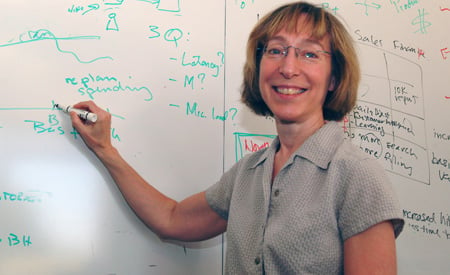This article is more than 1 year old
PARC turns 40: mice, money, and the new interwebs
A place whose time has come. Again
In hipsters we trust
Two projects illustrate what PARC's got in mind.
Magitti is a mobile application with a one-handed, touch interface for use on smartphones that detects activities and offers suggestions for users. The app was built for kids heading into Tokyo on the train who are holding onto the overhead carriage handles - hence the need for one-handed operation - and who haven't got time to blindly browse the mobile web. The idea is that it makes recommendations on what to do and where to hang out.
Built for publishing giant Dai Nippon Printing (DNP) and set to be rolled out as an iPhone application this year, Magitti was developed and researched using a PARC team of engineers and ethnographers who worked on context modeling, preference modeling, recommender systems, location sensing, activity detection, mobile hand-held user interfaces, and text mining.
PARC modeled between 60 and 100 possible scenarios for DNP, but identified Tokyo-bound teenagers as the ideal potential demographic. The whole process took three years. "We didn't know it would be teenagers in Tokyo," Lunt confessed. "We went through scenarios, narrowed it down, fleshed it out, narrowed it down, and went into the field and tested it. I don't think Microsoft or many companies could do much of that."
The other example of what PARC's got in mind is Meshin, a venture-capital-style spin-out that began life as project Maestro. Meshin claims to be the first semantic side bar for Microsoft's Outlook that organizes, sorts, and displays important and linked information in your inbox based on the information's context. Meshin's in beta, and - like Magitti - was built using PARC's various team disciplines in natural language, ethnography, contextual intelligence, personal information management, intelligent image, and document processing.

Lunt: Foursquare and Facebook scratch the surface of ubiquitous computing (photo by Gavin Clarke)
"We are just starting with their emails with links," Lunt said. "We are convinced there will be a big future around this kind of technology, but we don't know how it will play out. We are trying to establish a number of the pieces so we can start doing the experiments a lot earlier on than the others who are focused on a much shorter timeline."
Spend enough time talking to anybody involved with PARC's present or past and at some point, they'll tell you the same thing: contrary to popular thinking, the "ideation" phase of development is "easy." That takes just 20 per cent of your time. Developing that idea into a successful or desirable technology or business is the sweaty part. Given PARC's past in letting good ideas go to outsiders, what's PARC got in mind to make money off CCN, Magitti, and Meshin?
According to St. Claire, nothing's "off the table" when it comes to exploiting the commercial potential of CCN, and PARC wants to work with different vertical sectors and application providers. That could mean co-development relationships, royalties on the IP once CCN is launched, and a potential open-source play, with PARC keeping back certain features that are charged-for under some kind of premium service. PARC is in talks with unnamed networking, cellphone, and consumer electronics companies. "It's a proven technology that now needs to be developed for certain applications," she said.
Lunt expects payback along the way from incremental developments, not just one big final release of CCN. "It resonates with people in the industry. They know they have these huge problems - like the mobile back hole and with getting bandwidth to smart phones. Those guys are in a lot of pain, so they get really excited when they hear this. They see the potential of CCN, then the discussion gets to the details: what are the barriers to overcoming this, what are the short-term wins to get more people in?"
With Magitti, DNP acquired the technology platform, technical expertise, and core intellectual property, while the goal of the Meshin is to win customers – or get bought. "With ubiquitous computing we are going through a similar exercise of how do we take these many, many years of knowledge and drive a path to something people can touch and hold and use," St. Claire said. PARC's also got Silicon Valley's venture capitalists eager to know what's in the labs that they can invest in, she added.
Hard lessons
Start-ups, spin-outs, collaborations, capitalizing on multi-disciplinary teamwork? PARC has been here before.
Stung by the exit of Metcalfe, who founded 3Com - bought by HP in 2009 for $2.7bn - and the loss of John Warnock, who formed document and graphics leader Adobe with the head of PARC's Imaging Sciences Laboratory, Charles Geschke, PARC got serious in the early 1980s.
William Spencer, PARC's director between 1982 and 1986, began the practice of taking a stake in the companies that its brains founded, while Xerox created Xerox Technology Ventures in 1989 to spin out companies.
This has resulted in more than 30 new spinouts ahead of Meshin, all based on PARC's technology and ideas, staffed by PARC people, and with many snapped up by giants Microsoft, Google, EMC, and Time Warner. Among them: ContentGuard, Documentum, and Powerset, with many others outside of computing in text analytics, solar concentrators, and silicon-sensor arrays used in medical, industrial, military, and security X-ray imaging.
